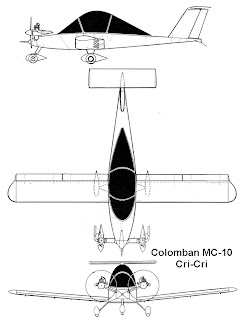So you wanna fly this real smallest aircraft in the world? Michael Colomban Cri cri - Cricket Aircraft - Cri cri plan - Cricri construction - Drawing Plan
Tuesday, December 30, 2008
Monday, December 15, 2008
Cricri 3d model Sketch Up Download
Friday, October 31, 2008
Wednesday, October 29, 2008
Cricri aircraft with jets engine
| |
| |
| |
| |
| |
Noted French pilot Nicolas Charmont has installed 2 AMT Olympus turbines in his Cri Cri together with AMT on-board automatic start-up units and individual EDT's. The Cri Cri weighs 170 Kg, and should have enhanced performance withover 36 Kg of thrust available. The Cri Cri has made his maiden flight in the weekeind of 7-8 March. More info :http://www.amtjets.com/ |
Tuesday, October 28, 2008
Download Cricri aircraft video
| | Formation flight with that intriguing airplane, Michel Colomban's Cricri MC15. Known to be the smallest twin-engined airplane in the world (4.90m wingspan, 72kg empty weight, 2x15HP), it still has a 190km/h cruise speed and is capable of executing all the basic aerobatic maneuvers.
|
Cri cri 3 view drawings

| Min speed: | 39 kt | 45 mph | 72 kmh |
| Cruise speed: | 108 kt | 124 mph | 200 kmh |
| Vne: | 159 kt | 183 mph | 295 kmh |
Climb ratio: 600 ft/min | 3 m/s
Take off distance over 50ft (15m) obstacle: 330 ft | 101 m
Landing distance over 50ft (15m) obstacle: 495 ft | 151 m
Max. take off weight: 170 kg | 375 lbs
Empty weight: 80 kg | 176 lbs
Engine: 2 JPX PUL 212 engines, 15 hp each
Other aircraft information:
It was in 1971, when aircraft designer Michel Colomban started work on this small aircraft Cri Cri with two engines. His target was to build small, economis plane with two engines, which would be able to flying also some aerobatic maneuvers. Price of this plane shouldn't exceed 1000 USD, including two engines - these prises are from 1970, of course:-). Constructional works took around 1500 working hours, and than was Cri-Cri plane, which name is after nickname of Michel's daughter, prepared for it's first flight.
Text from: http://flight.cz/cricri/english/index.php
Performance Table
| MC-10 | Cri-Cri | MC-12 Cricket MC-12 Cricket |
| Wingspan | 5 m 5 m | 4,9 m 4,9 m |
| Captain | 3,9 m 3,9 m | |
| Wing area | 3,1 m2 3,1 m2 | |
| Re-air | 63 kg 63 kg | 75 kg 75 kg |
| Take-off weight | 170 kg 170 kg | |
| Wing load | 55 kg/m2 55 kg/m2 | |
| Engine Model | 2x 9PS 2x 9PS | 2x 15PS 2x 15PS |
| Overload factor | +9G, -4,5G +9 G, -4,5 G | +9G, -4,5G +9 G, -4,5 G |
| Maximum speed | 200 km/h 200 km / h | 250 km/h 250 km / h |
| Cruising speed | 170 km/h 170 km / h | 185 km/h 185 km / h |
| Rate of climb | 3 m/s 3 m / s | 6 m/s 6 m / s |
| Roll away | 150 m 150 m | 120 m 120 m |
| Ceiling | 5500米 5500 m | |
| Voyage | 750 km 750 km | 500 km 500 km |
Cri Cri World Smallest Twin Engine Aircraft
The Cri-Cri is a popular homebuilt design developed in France by engineer and pilot Michel Colomban. Colomban became fascinated by small aircraft and hoped to create a tiny and economical plane with good performance and aerobatic capabilities. His goal was a very simple and lightweight construction using no more than a 20-hp engine powering an airframe carrying a 172 lb (78 kg) pilot and 22 lb (10 kg) of fuel. Colomban's initial study in the late 1950s suggested that a single seat aircraft with a maximum takeoff weight of 395 lb (180 kg) and a wing area of 43 ft² (4 m²) was feasible.
Over a decade later, Colomban returned to his pet project but was able to make several improvements due to advances in technology. He incorporated new more efficient low-drag airfoils, composite parts, and thinner sheet metal for the wing skin to reduce weight and wing area to just 33 ft² (3.1 m²). The new aircraft also adopted twin 8-hp Stihl chain-saw engines, like those used aboard ultralights, in place of the planned single 20-hp engine. The change not only made the aircraft lighter but also improved the efficiency of each engine's propeller. Construction of the first example took about 1,500 hours, and several structural load tests were conducted to prove its advanced design elements were safe.


